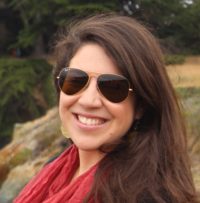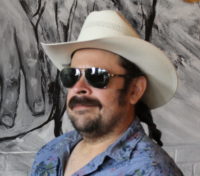Climate change could fuel next wave of immigrants from Latin America
UC Berkeley Michael Bakal's research suggests that the combination of drought and rising heat could force Guatemalan farmers to head north to feed their families.
July 8, 2019

Earning a living corn farming in Guatemala has become ever more difficult during an ongoing drought, and Berkeley researcher Michael Bakal suggests continued difficulty farming could lead to increased Guatemalan immigration to the United States. (Photo by Tomas Castelazo via Wiki Commons)
Global climate change is likely to exacerbate the ongoing immigration crisis in the United States, according to field research being done this summer in Guatemala by a UC Berkeley Ph.D. student funded by the Center for Latin American Studies.
Michael Bakal, who will be teaching at the School of Public Health this fall, is working among the farming population, and says Guatemalan farmers have been hit hard by climate change in the form of drought.
In the first three weeks he spent in the small town of Rabinal in central Guatemala, during what is usually the rainy season, Bakal says rain fell on just three days. He says when he first came to the area 10 years ago, it rained every day.
If the drought doesn’t abate, he suggests the push of Guatemalans who will head toward the United States could dwarf the current size of the Central American country’s flow northward, as many of the region’s farmers will have to leave in order to feed their families.
Guatemalans, fueled by the desire to escape poverty and a high murder rate, have already supplanted Mexicans as the largest immigrant population knocking on the United States’ door. And now, the ravages of climate change could add impetus to the exodus.
“With rising sea levels and rising heat, the major impact is that (Guatemalans) are in crop failure,” Bakal says. “It’s not talked about, but there is no doubt in the mind of any farmer here that climate change is manifesting itself in more heat, less rainfall and longer times between rains. Corn is the basis of the diet here; corn and beans allowed civilization to form here. It’s all in jeopardy now.”
When he isn’t in Berkeley’s Graduate School of Education, Bakal often can be found in Guatemala. In 2009, he was one of the co-founders of Voces y Manos (Voices and Hands), a program designed to empower Guatemalan youth. The program’s students are encouraged to develop programs to help improve child nutrition, combat deforestation and promote sustainable agriculture, with enticing college scholarships and internships offered to them as rewards.

Returning migrant high school students in Oaxaca, Mexico, use this outside space for their club meetings. They call themselves the New DREAMers, and meet to discuss problems they encounter upon return, exchange migration stories, and practice their English with each other. (Photo courtesy of Adriana Ramirez)
“We’ve been working on youth empowerment projects,” Bakal says. “The way the program works, the aim is to prepare indigenous leaders who can improve a variety of health and social conditions in their communities.”
Bakal’s summer research is dedicated to seeing how the Rabinal area can be helped by teaching residents water and soil conservation, contour farming, composting and vaccination of animals. Bakal says he has some optimism “that we can make a positive impact, but whether it will be sufficient, no one knows.”
Bakal is working with about 300 families, but he says “it’s such a drop in the bucket.”
“This is a pilot project, and it needs to be done at a much larger level,” he says. “The most important thing we can do is to raise consciousness, particularly in the U.S. Climate change is not just about San Francisco, New York and Miami. We are talking about the possible collapse of agriculture in large swaths of the world. If migration is bad now, what will it be when farmers can’t survive?”
Julia Byrd, the vice-chair of CLAS, says Bakal’s research on climate change and immigration “is important” because they are often blurred by political chatter.
Each summer, CLAS gives foundation grants to between 15 and 30 Berkeley faculty and graduate students to do research throughout Central and South America in city planning, public health, history, languages and other areas. It’s an effort to uncover quality, in-depth information about Latin America and to share it with — and bring awareness of it to — an American audience.
Other CLAS-funded researchers are doing work that will enable them to tell additional stories about the immigration struggles impacting the Western Hemisphere.

Adriana Ramirez
Adriana Ramirez, who is finishing up her dissertation this summer after working in Oaxaca, Mexico, is largely studying the immigration of people from the United States to Mexico — not the other way around. And Salvador Gutierrez Peraza, at the beginning of his dissertation process, is doing research on Haitians who have settled in his hometown of Mexicali, Mexico.
For the past two years, Ramirez has done a series of interviews in person and via FaceTime with about three dozen youth and young adults in Oaxaca who have ties to the United States. Some were born north of the border. Others, born in Mexico, were living as undocumented immigrants in the United States. All of them call Oaxaca home, but many said they would try to immigrate back to the United States, at some point.
Ramirez says most of the people she’s interviewed see the United States as the ultimate destination. Those born in the United States, even if they return to Mexico for family reasons, have the American dream, she says.
“Mostly, they still plan to come back to the States to study,” she says. ‘They still see the U.S. as a place of opportunity. They see it as a right or a duty to go back to the country they were born in.”
Immigrants who are undocumented in the United States also “identify with the U.S. culture and have a hard time adjusting to their parents’ home town” if they have to return to Mexico, she says.

Salvador Gutierrez Peraza
Unlike Tijuana, the prime Mexico-to California immigration point directly across from San Diego, the city of Mexicali— the capital of the state of Baja California — 112 miles to the east, isn’t getting the same media attention. Gutierrez Peraza says the immigrant story in Mexicali is pronounced, despite its scarce resemblance to Tijuana’s.
He says there are immigrants who want to cross into the small California city of Calexico that’s just across the border from Mexicali, immigrants using Mexicali as a stopping point en route to Tijuana, and immigrants willing to start life anew in Mexicali. Mostly, it’s become a magnet for Haitian immigrants, who speak French.
“About three years ago, a large influx of Haitians started coming here, and the flow hasn’t really stopped,” Gutierrez Peraza says. “Speaking French, they are easy to spot. What I’m seeing is that, while a lot of them move on, a lot are staying, and they are assimilating. People in Mexicali see Central Americans as more transient and seem very happy with the Haitians’ presence, because they see them wanting to work for a living and wanting to integrate into society.
“Those are the kinds of stories that CLAS helps us get, that people need to hear about. Talking about immigration just in terms of Donald Trump is low-hanging fruit. The students that CLAS sends out are activists. These are people who want to pursue work in the field to see if they can initiate change.”
Byrd says CLAS doesn’t choose summer research topics for students and faculty, or mind if occasionally a researcher changes course after landing in Latin America.
“It’s just important, from our point of view, that these issues get addressed,” she says. “And the results they get are important.”